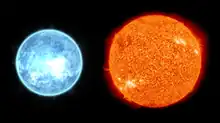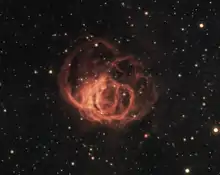| Observation data Epoch J2000.0 Equinox J2000.0 | |
|---|---|
| Constellation | Sagittarius |
| Right ascension | 17h 45m 47.541s[1] |
| Declination | −26° 10′ 27.78″[1] |
| Apparent magnitude (V) | 14.10[2] |
| Characteristics | |
| Evolutionary stage | Wolf–Rayet star |
| Spectral type | WO2[3] |
| B−V color index | +0.77[4] |
| Astrometry | |
| Proper motion (μ) | RA: +0.672[1] mas/yr Dec.: −0.059[1] mas/yr |
| Parallax (π) | 0.3421 ± 0.0208 mas[1] |
| Distance | 9,500 ± 600 ly (2,900 ± 200 pc) |
| Absolute magnitude (MV) | −1.46[5] |
| Details | |
| Mass | 16.1+1.7 −1.4[5] M☉ |
| Radius | 0.52[5] R☉ |
| Luminosity | 380,000[5] L☉ |
| Temperature | 200,000[5] K |
| Metallicity [Fe/H] | 0.0[3] dex |
| Other designations | |
| Database references | |
| SIMBAD | data |

WR 102 is a Wolf–Rayet star in the constellation Sagittarius, an extremely rare star on the WO oxygen sequence. It is a luminous and very hot star, highly evolved and close to exploding as a supernova.
Discovery
WR 102 was first mentioned as the possible optical counterpart to a peculiar X-ray source GX 3+1.[6] However, it became clear that it was a separate object and in 1971 it was highlighted as a luminous star with unusual OVI emission lines in its spectrum.[7] It was classified as a WC star, an unusual one because of the highly ionised emission lines, and not the central star of a planetary nebula.[6][8] It was seen to vary in brightness and was given the variable star designation V3893 Sagittarii in the 62nd name-list of variable stars.[9]
Faint nebulosity was discovered around WR 102 in 1981 and was identified as a wind-blown bubble.[10] In 1982, a set of five luminous stars with highly ionised oxygen emission lines, including WR 102, was used to define the WO class of Wolf–Rayet stars. They were identified as highly evolved massive stars.[11]
Features

WR 102, of spectral classification WO2, is one of the very few known oxygen-sequence Wolf–Rayet stars, just four in the Milky Way galaxy and nine in external galaxies. It is also one of the hottest known, with a surface temperature estimated to be at 210,000 K. Modelling the atmosphere gives a luminosity around 95,500 L☉,[5] while calculations from brightness and distance gives a luminosity of 380,000 L☉ (assuming a temperature of about 200,000 K) with a distance of 2,900±200 pc.[1][5] WR 102 was likely born from the OB association Sagittarius OB5.[12] It is a very small dense star, with a radius around 0.52 R☉ and a mass of 16.1 M☉.[5]
Very strong stellar winds with a terminal velocity of 5,000 kilometers per second are causing WR 102 to lose 10−5 M☉/year.[2] For comparison, the Sun loses (2-3) x 10−14 solar masses per year due to its solar wind, several hundred million times less than WR 102. These winds and the strong ultraviolet radiation from the hot star have compressed and ionised the surrounding interstellar material into a complex series of arcs described as the bubble type of Wolf–Rayet nebula.[13]
Evolutionary status
WO stars are the last evolutionary stage of the most massive stars before exploding as supernovae.[14] It is very likely that WR 102 is on its last stages of nuclear fusion, near or beyond the end of helium burning.[15]
It has been calculated that WR 102 will explode as a supernova within 1,500 years.[3] High mass and rapid rotation would make a gamma-ray burst (GRB) possible,[14] but it is unclear if WR 102 is rotating rapidly.[3] It was previously thought that the projected rotation velocity within the stellar wind could be as fast as 1,000 km/s[2] but spectropolarimetric observations seem to indicate that if WR 102 is rotating, it is rotating at a much lower speed.[16]
See also
References
- 1 2 3 4 5 6 Vallenari, A.; et al. (Gaia collaboration) (2023). "Gaia Data Release 3. Summary of the content and survey properties". Astronomy and Astrophysics. 674: A1. arXiv:2208.00211. Bibcode:2023A&A...674A...1G. doi:10.1051/0004-6361/202243940. S2CID 244398875. Gaia DR3 record for this source at VizieR.
- 1 2 3 Sander, A.; Hamann, W. -R.; Todt, H. (2012). "The Galactic WC stars". Astronomy & Astrophysics. 540: A144. arXiv:1201.6354. Bibcode:2012A&A...540A.144S. doi:10.1051/0004-6361/201117830. S2CID 119182468.
- 1 2 3 4 Tramper, F.; Straal, S. M.; Sanyal, D.; Sana, H.; de Koter, A.; Gräfener, G.; Langer, N.; Vink, J. S.; de Mink, S. E.; Kaper, L. (2015). "Massive stars on the verge of exploding: The properties of oxygen sequence Wolf-Rayet stars". Astronomy & Astrophysics. 581 (110): A110. arXiv:1507.00839v1. Bibcode:2015A&A...581A.110T. doi:10.1051/0004-6361/201425390. S2CID 56093231.
- ↑ Smith, Lindsey F.; Shara, Michael M.; Moffat, Anthony F. J. (1990). "Distances of Galactic WC stars from emission-line fluxes and a quantification of the WC classification". The Astrophysical Journal. 358: 229. Bibcode:1990ApJ...358..229S. doi:10.1086/168978. ISSN 0004-637X.
- 1 2 3 4 5 6 7 8 Sander, A. A. C.; Hamann, W.-R.; Todt, H.; Hainich, R.; Shenar, T.; Ramachandran, V.; Oskinova, L. M. (2019). "The Galactic WC and WO stars". Astronomy & Astrophysics. 621: A92. arXiv:1807.04293. Bibcode:2019A&A...621A..92S. doi:10.1051/0004-6361/201833712. S2CID 67754788.
- 1 2 Sanduleak, N. (1971). "On Stars Having Strong O VI Emission". The Astrophysical Journal. 164: L71. Bibcode:1971ApJ...164L..71S. doi:10.1086/180694.
- ↑ Stephenson, C. B.; Sanduleak, N. (1971). "Luminous stars in the Southern Milky Way". Publications of the Warner & Swasey Observatory. 1: 1. Bibcode:1971PW&SO...1a...1S.
- ↑ Stenholm, B. (1975). "Wolf-Rayet stars and galactic structure". Astronomy and Astrophysics. 39: 307. Bibcode:1975A&A....39..307S.
- ↑ Kukarkin, B. V.; Kholopov, P. N.; Fedorovich, V. P.; Kireyeva, N. N.; Kukarkina, N. P.; Medvedeva, G. I.; Perova, N. B. (1977). "62nd Name-List of Variable Stars". Information Bulletin on Variable Stars. 1248: 1. Bibcode:1977IBVS.1248....1K.
- ↑ Chu, Y. -H (1981). "Galactic ring nebulae associated with Wolf-rayet stars. I. Introduction and classification". The Astrophysical Journal. 249: 195. Bibcode:1981ApJ...249..195C. doi:10.1086/159275.
- ↑ Barlow, M. J.; Hummer, D. G. (1982). "The WO Wolf-rayet stars". Wolf-Rayet Stars: Observations. 99: 387–392. Bibcode:1982IAUS...99..387B. doi:10.1007/978-94-009-7910-9_51. ISBN 978-90-277-1470-1.
- ↑ Goss, W. M.; Lozinskaya, Titiana A. (1995-02-01). "Radio and IRAS observations of two nebulae around WO stars: G2.4+1.4 in the Galaxy and Sandage H II region 3 in IC 1613". The Astrophysical Journal. 439: 637–645. doi:10.1086/175203. ISSN 0004-637X.
- ↑ Toalá, J. A.; Guerrero, M. A.; Ramos-Larios, G.; Guzmán, V. (2015). "WISE morphological study of Wolf-Rayet nebulae". Astronomy & Astrophysics. 578: A66. arXiv:1503.06878. Bibcode:2015A&A...578A..66T. doi:10.1051/0004-6361/201525706. S2CID 55776698.
- 1 2 Groh, Jose H.; Meynet, Georges; Georgy, Cyril; Ekstrom, Sylvia (2013). "Fundamental properties of core-collapse Supernova and GRB progenitors: Predicting the look of massive stars before death". Astronomy & Astrophysics. 558: A131. arXiv:1308.4681v1. Bibcode:2013A&A...558A.131G. doi:10.1051/0004-6361/201321906. S2CID 84177572.
- ↑ Groh, Jose H.; Meynet, Georges; Ekström, Sylvia; Georgy, Cyril (2014). "The evolution of massive stars and their spectra I. A non-rotating 60 Msun star from the zero-age main sequence to the pre-supernova stage". Astronomy & Astrophysics. 564: A30. arXiv:1401.7322. Bibcode:2014A&A...564A..30G. doi:10.1051/0004-6361/201322573. S2CID 118870118.
- ↑ Stevance, H F; Ignace, R; Crowther, P A; Maund, J R; Davies, B; Rate, G (2018). "Probing the rotational velocity of Galactic WO stars with spectropolarimetry". Monthly Notices of the Royal Astronomical Society. 479 (4): 4535–4543. arXiv:1807.02117. Bibcode:2018MNRAS.479.4535S. doi:10.1093/mnras/sty1827. S2CID 119102624.